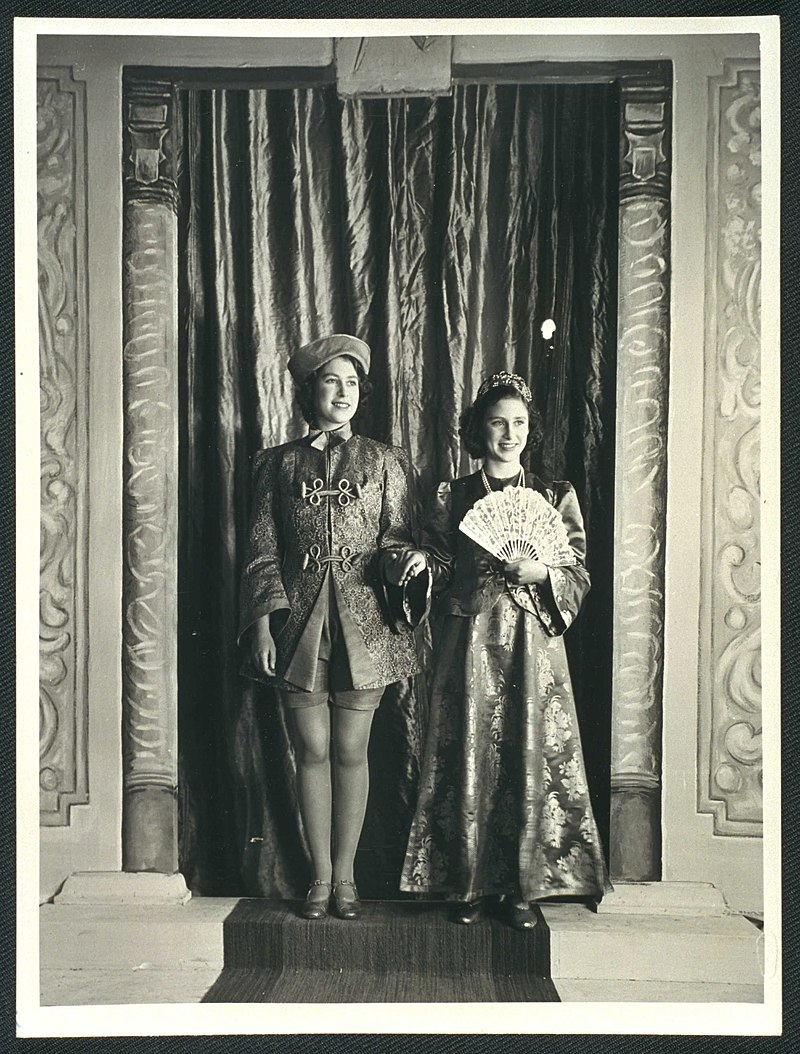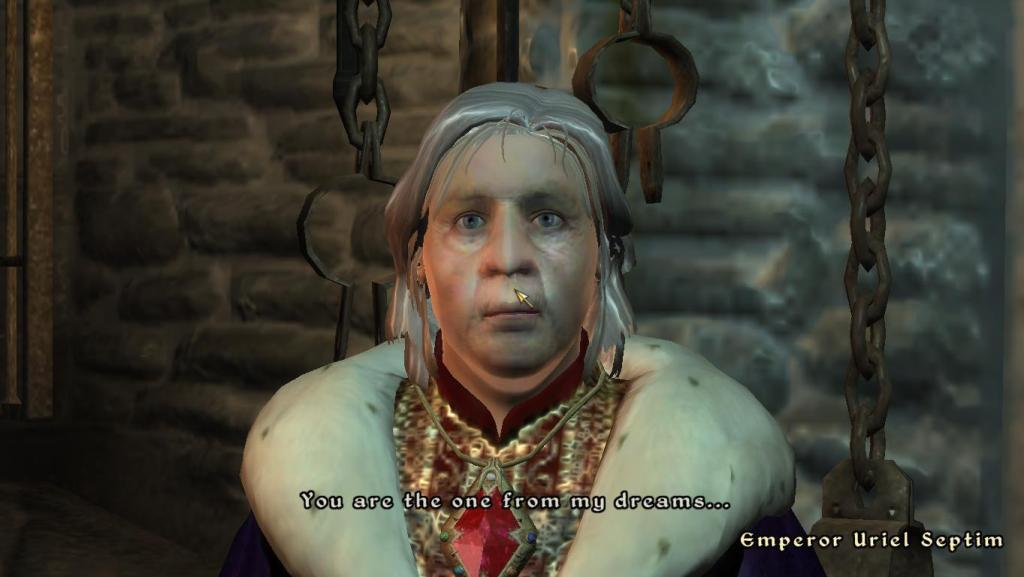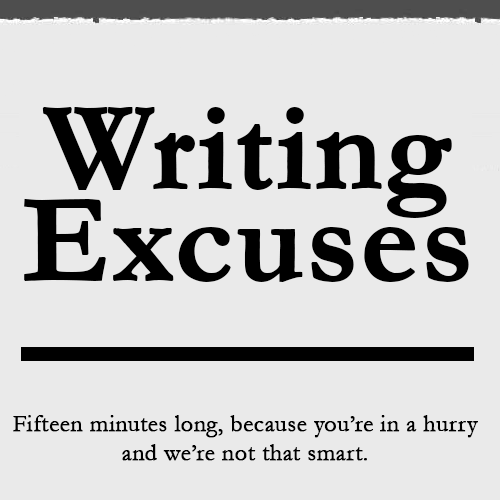Beyond: Two Souls falls between these, as the lure of the QTE proved too much; to gamify the experience, the buttons are swapped around, meaning any instincts you do develop just get in the way. At least they are semi real-time, and not cutscenes that go on so long you forget you might need to press a button soon.
***
All of this, however, is just interactivity. Your core engagement with a game is, well, playing the game. Although in a game like Mass Effect you can make significant choices that influence game events two games later, you make these through choosing a line of dialogue.
In Skyrim you can make an early-game choice on whether you align with Empire or Stormcloak -- but you make it by turning left or right (and under conditions where it is not at all clear you are making a choice at all).
The point being, the core gameplay skills, the thing you worked at all game to become better at, has nothing to do with these choices. Okay, here's an even more clear example:
In Horizon: Forbidden West you gain renown over defeating Regalla's champion at the ambush of the Embassy. Random Tenach will recognize you the moment you walk into their village (apparently you are the only ginger in California) and they are all impressed about that fight.
But the only gameplay involved was to win the fight. Which you have to do to continue the game anyhow. The thing of it is, even at this early stage of the game Aloy has a lot of options. She could snipe at him from cover, she could do a close-up beat-down with the spear. She could take over a machine and let it trample him! The fight could be a hard-won victory or a curb-stomp.
None of this matters. Not a one of those random villagers says "...and you did it face-to-face like a true warrior" or "...even if you did have to use booby-traps."
For all the options the game gives you, none of the Ancestor-obsessed Quen ever notice that you are dressed like Elizabeth Sobek (if you chose that outfit). None of the proud Tenach notice when you've started collecting your own tribal tattoos (okay...you only get face paint. But still!)
Out of a whole bunch of games, only Skyrim comes to mind as one where random passers-by will notice the difference between you being a khajit wearing leather armor, or a Nord in head-to-toe shimmering magically-enhanced ebony armor. And the muggers won't notice, thinking you are an easy mark either way.
But this is still a sideline. The closest I can think of a game noticing how you play the game is that, if you blow stealth (or never attempt it) your companion NPC (in more than one game) might say, "I guess we're doing it the noisy way, then."
Take another situation that comes up quite often. Big fight against an important character. You "win" via normal game mechanics. Enter a cut scene where somehow, despite taking a nuke to the face, the guy is lying on the floor saying "I give up."
At which point you have a dialogue wheel on whether to kill them forgive them or whatever.
Okay, sure, I can accept this for important characters and important choices. You want to savor it, it wants to be dramatized properly. So you really do have to do it out of "melee time."
But then you get to something like Skyrim's "yield" mechanics. Or complete lack of mechanics. Some enemies will stop fighting and throw down their weapons. Same for Fallout 4 (same engine, after all). So can you tell them to run, can you take them prisoner, can you order them to give up their loot?
No. You can wait for them to recover enough health points to...try and kill you again. (Your followers are smarter than that; they simply ignore the fake surrender).
One of the few places I can think of where how you play the combat matters is when there is a strong stealth component. And even there it is rare to go as far as some entries in the Metal Gear series, where the people you killed (instead of stealthing your way past) return as ghosts to torment you.
In Beyond: Two Souls if you chose (as Aiden) to kill the guard in the Embassy scene (not to be confused with Forbidden West's Embassy scene!) Jodie will have a horrified reaction, yelling "You didn't have to kill him!" (In a different sequence, if you let Aiden take bloody revenge on Jodie's tormenters at the party scene...she's wearing goth clothing in the next scene chronologically.)
That's about the extent of it for most games. You can't change the game by stealthing...or by using flame preferentially to roast your assailants alive. Nobody notices if you are a stealth archer...or have the subtlety of Bulldog Drummond.
And more than that. Whether you fought well or didn't fight well, it doesn't open up significant story options. In many games, that gameplay loop is hermetic. Win tougher fights, earn better weapons. The story progresses regardless.
It is tempting to think of the problem as one of combat. There are games where combat is not the most-used skill, and skillfully moving through dialogue trees is what both progresses you through the story and earns you different stories.
And you can absolutely put your stamp on the game experience if it isn't primarily a combat game.
As I've said before, combat is the go-to because for the cost of basic enemy AI and some variety of weapons, you get a semi-emergent behavior; you get variety that allows endless hours of play that don't feel all the same. When you have to craft every line of dialogue, every button prompt, it is hard for a game to provide that same length of play. And like it or not, playable time is one of the measures of value for a game.
It gets worse, though. Combat works because it is a "twitch" activity. And... yeah, I'm not harping, it is just that this is such a good example for some of my points. And also inspired my thinking. Anyhow, Beyond: Two Souls comes close to failing this because the things that are timed are the things that really shouldn't be timed (like dialogue choices) and the things that are timed, aren't timed in the way that makes them satisfying.
THIS is not combat.
THIS is.
You have events unfolding in real time but more importantly you have options which you can access instinctively. Finishing a QTE sequence can be tough and can be annoying, but you never get that sense of
control in having made a choice about what action to take and carrying it out successfully (or not).
***
Is there a way a game can tie this satisfying and common aspect of games to the advancement of story? To things that change your personal experience and the world your character inhabits?
Or is it already too much of a stretch goal asking developers to spend time in design and testing on paths in a game a significant number of players will never encounter? That's like a bakery choosing to make six highly decorated cakes for every one that is actually sold.
But I don't think it is a stretch goal for game to react more to your actions outside the sometimes extremely small number of scripted branches. On the one side, we have Skyrim guards noticing if you have skill in magic, and even cautioning you if you have a flaming weapon out. On the other side, we have AAA games spending a tremendous amount of time on not-always-well-integrated collectibles and achievements and cosmetics.
Go back to that facepaint. In Forbidden West, you need to complete certain quests to unlock certain patterns, collect the pigments from various hard-to-reach locations, then bring both to the merchants in some towns who will apply them.
And at the end...Aloy looks different. At least this is a game with fully animated dialogue scenes so you get to SEE Aloy's face in-game.
After all of this, was it really a bridge too far to have a passing stranger recognize Seeker colors and mention it?
















